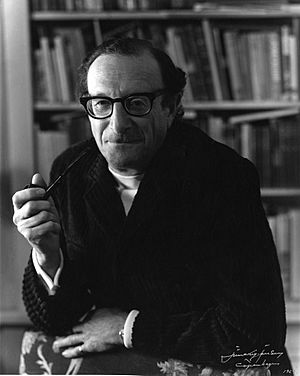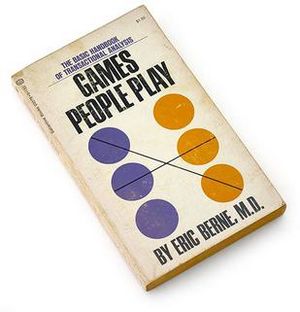Eric Berne facts for kids
Quick facts for kids
Eric Berne
|
|
|---|---|
 |
|
| Born |
Eric Lennard Bernstein
May 10, 1910 |
| Died | July 15, 1970 (aged 60) |
| Nationality | Canadian |
| Known for | Developed the theory of Transactional analysis |
| Spouse(s) |
Ruth Harvey
(m. 1942; div. 1945)Dorothy DeMass Way
(m. 1949; div. 1964)Torre Peterson
(m. 1967; div. 1970) |
| Children | 4 |
| Scientific career | |
| Fields | Psychiatry |
| Influences | Sigmund Freud, Erik Erikson, Wilder Penfield, René Spitz |
| Influenced | Thomas Anthony Harris, Albert Mehrabian, Claude Steiner |
Eric Berne (May 10, 1910 – July 15, 1970) was a doctor from Canada who studied the mind. He created a special way to understand how people act and talk to each other. This idea is called transactional analysis.
Berne's ideas were different from other famous thinkers like Sigmund Freud. Freud's doctors often focused on talking about past feelings. Berne, however, looked at how people interact right now. He believed understanding these "transactions" could help people better understand themselves.
Contents
Early Life and Education
Eric Berne was born in Montreal, Canada, on May 10, 1910. His original name was Eric Lennard Bernstein. His father was a doctor, and his mother was a writer. Eric loved going with his father to visit patients, even in the cold Canadian winters.
When Eric was 11, his father passed away. His mother worked hard as a writer to support the family. She encouraged Eric to become a doctor, just like his dad.
Eric studied medicine at McGill University in Montreal. He earned his doctor's degree in 1935. In 1939, he became an American citizen. He also shortened his name from Eric Lennard Bernstein to Eric Berne.
Becoming a Psychiatrist
After medical school, Berne moved to the United States. He worked at a hospital in New Jersey for a year. Then, he studied psychiatry at Yale University for two years. Psychiatry is the study of mental health.
From 1938 to 1943, Berne worked as a psychiatrist in different places. He also had his own private practice. In 1943, during World War II, Berne joined the United States Army. He worked as a psychiatrist for the army and rose through the ranks.
After the war in 1946, Berne moved to Carmel-by-the-Sea, California. He lived in a historic house there, built in 1888. This house is now known as the "Eric Berne House." He continued his private practice in both Carmel and San Francisco. He also kept up with his research and teaching.
Berne continued his special training in understanding the mind. He studied with Erik Erikson, another famous psychologist. He also worked at different hospitals and clinics, helping many people.
Games People Play
One of Eric Berne's most famous books is called Games People Play: The Psychology of Human Relationships. It was published in 1964 and became a huge bestseller. More than five million copies have been sold!
The book talks about how people interact with each other. Berne called these interactions "games." These "games" are not always about winning or losing. Instead, they are often about getting a certain feeling or playing a role. Even if someone seems to "lose" a game, they might still get something out of it, like attention.
Berne wrote this book for other doctors and therapists. But it became popular with everyone because it clearly showed how people play these "games" in everyday life. He explained that any social interaction is better than no interaction at all. People need some form of "stroking," or attention, to feel connected.
Personal Life
Eric Berne was married three times and had four children. He was known for his great sense of humor. He often used funny fake names, called pseudonyms, in his writings. One of his pseudonyms was Cyprian St. Cyr.
Death
Eric Berne passed away from a heart attack in Carmel, California, on July 15, 1970. He was 60 years old.
See also
 In Spanish: Eric Berne para niños
In Spanish: Eric Berne para niños
- Claude Steiner
- Karpman drama triangle
- Mind games
- Script analysis


